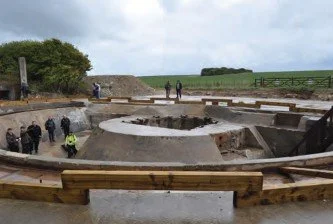Kent Defence Research Group Visit to Dover
By Clive Holden (Chair, KDRG)

A damp September morning saw us gathering at the National Trust’s White Cliffs site at Dover to tour their Fan Bay and Wanstone Second World War gun battery sites.
Both sites are subjects of the NT’s three-year ‘Wanstone Rediscovered’ project, funded with a substantial grant from the National Lottery Heritage Fund and donations and support from local businesses. The project officially started on 1 July 2022 and is being delivered by existing and new volunteers who will be recruited locally.
Although primarily arranged for KDRG and KAS members, the visit was also opened up to the volunteers and trustees from the Slough Fort Preservation Trust. All made for an enthusiastic and keenly interested group that met up in the light showers of rain. Having monitored the Met Office forecasts for the day, I proclaimed confidently to the group, ‘Don’t worry guys – this is as bad as it’s going to get’ as we set off over the fields to the Fan Bay site for guided tours of the deep battery shelter.
By the time we arrived, the rainfall had got steadily harder, and we were glad to be descending the 125 steps down to the shelter. Fan Bay Battery was constructed in 1940-41 and comprised three 6-inch guns. The deep shelter was excavated twenty-three metres below the clifftops by the Royal Engineers to provide protected accommodation for the battery personnel. The guided tour also took us out of the shelters to view the two concrete sound mirrors set into the cliff face, one dating from 1917 and the other from the 1920s. The sound mirrors were an early form of aircraft detection which worked by picking up the sounds of aircraft engines as they approached across the Channel. The advent of radar in the 1930s made them obsolete.
The shelter tour at an end, we ascended the steep stairs to find the rain now coming down in proverbial ‘sheets’. Hence, we were a very sodden group by the time we made it back to Wanstone for a look around the site of one of the 15-inch gun emplacements and its associated buildings.

The battery was constructed in 1941-42, and, as with Fan Bay Battery, the guns were removed in the 1950s, and the emplacements were buried in the 1970s. The main work of the ‘Wanstone Rediscovered’ project for this year has been the excavation of
No.1 gun emplacement (wartime nickname ‘Jane’). The excavation of the No.2 gun emplacement (wartime nickname ‘Clem’) is planned for 2024.

We took cover from the continuing torrential rain in the gun’s crew shelter, and when it eased off, we inspected the recently excavated gun emplacement and one of its magazines.
Our final tour of the day was of the adjacent Swingate heavy anti-aircraft gun battery (designated ‘D2’). Comprising four 3.7-inch guns, the battery was operational from 1938 to the mid-1950s. The gun emplacements, gun store, magazines and the Battery Command Post survive, as do the remains of a few other buildings.
Despite the awful weather, the whole group enjoyed the day immensely, and the KDRG intends to organize similar visits to other defence- related sites around the county in the future.
Finally, on behalf of the KDRG and the visiting group, I would like to express my sincere thanks to Jon Barker, NT Project Manager for ‘Wanstone Rediscovered’ for facilitating the visit, and we wish him and his team every success with the ongoing work on this fascinating and worthwhile project.
For more information on the activities of the Kent Defence Research Group can be found at:
https://kentarchaeology.org.uk/about-us/committees/kent-historic-defences
https://www.facebook.com/ KentDefenceResearchGroup/
